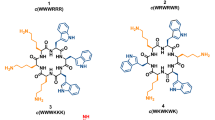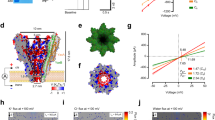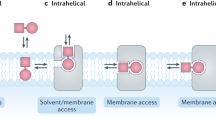Abstract
Partition coefficients (Kp) of drugs between the phospholipid bilayer and the aqueous phase provide useful information in quantitative structure-activity relationship studies. Hexadecylphosphocholine (HePC) micelles, composed of a zwitterionic hydrophilic surface and a hydrophobic core, mimic the biomembranes and have several advantages over other lipid structures to assess Kp values. Their preparation is easy, fast and avoids the use of toxic organic solvents, and the output has fewer spectroscopic interferences. Here, we describe a high-throughput microplate protocol for assessing the Kp of drugs using HePC micelles as membrane models and derivative spectrophotometry as the detection technique. Moreover, the time-consuming data treatment to assess Kp values is easily performed by a dedicated Excel routine developed here and described in detail. The Kp values of nonsteroidal anti-inflammatory drugs (acemetacin, clonixin, diclofenac and indomethacin) were determined to show the simplicity of the method and to validate this protocol, which provides Kp values (n = 3) of two drugs in ∼2 h.
This is a preview of subscription content, access via your institution
Access options
Subscribe to this journal
Receive 12 print issues and online access
$259.00 per year
only $21.58 per issue
Buy this article
- Purchase on Springer Link
- Instant access to full article PDF
Prices may be subject to local taxes which are calculated during checkout




Similar content being viewed by others
References
Di, L. & Kerns, E.H. Profiling drug-like properties in discovery research. Curr. Opin. Chem. Biol. 7, 402–408 (2003).
Seydel, J.K. & Wiese, M. Drug-Membrane Interactions: Analysis, Drug Distribution, Modeling (Wiley-VCH Verlag, Weinheim, 2002).
Avdeef, A. Physicochemical profiling (solubility, permeability and charge state). Curr. Top. Med. Chem. 1, 277–351 (2001).
Hansch, C. & Dunn, W.J. Linear relationship between lipophilic character and biological activity of drugs. J. Pharm. Sci. 61, 1–19 (1972).
Betageri, G.V. & Rogers, J.A. The liposome as a distribution model in QSAR studies. Int. J. Pharm. 46, 95–102 (1988).
Hansch, C., Leo, A., Mekapati, S.B. & Kurup, A. QSAR and ADME. Bioorg. Med. Chem. 12, 3391–3400 (2004).
Schultz, T.W., Cronin, M.T.D., Walker, J.D. & Aptula, A.O. Quantitative structure-activity relationships (QSARs) in toxicology: a historical perspective. Theochem. J. Mol. Struct. 622, 1–22 (2003).
Klopman, G. & Zhu, H. Recent methodologies for the estimation of N-octanol/water partition coefficients and their use in the prediction of membrane transport properties of drugs. Mini Rev. Med. Chem. 5, 127–133 (2005).
Oprea, T.I., Davis, A.M., Teague, S.J. & Leeson, P.D. Is there a difference between leads and drugs? A historical perspective. J. Chem. Inf. Comput. Sci. 41, 1308–1315 (2001).
Ong, S.W., Liu, H.L., Qiu, X.X., Bhat, G. & Pidgeon, C. Membrane partition coefficients chromatographically measured using immobilized artificial membrane surfaces. Anal. Chem. 67, 755–762 (1995).
Escher, B.I. & Schwarzenbach, R.P. Partitioning of substituted phenols in liposome-water, biomembrane-water, and octanol-water systems. Environ. Sci. Technol. 30, 260–270 (1996).
Wang, M.M., Sugar, I.P. & Chong, P.L.G. Role of the sterol superlattice in the partitioning of the antifungal drug nystatin into lipid membranes. Biochemistry 37, 11797–11805 (1998).
de Castro, B., Gameiro, P., Lima, J.L.F.C., Matos, C. & Reis, S. A fast and reliable spectroscopic method for the determination of membrane-water partition coefficients of organic compounds. Lipids 36, 89–96 (2001).
Takegami, S., Kitamura, K., Funakoshi, T. & Kitade, T. Partitioning of anti-inflammatory steroid drugs into phosphatidylcholine and phosphatidylcholine-cholesterol small unilamellar vesicles as studied by second-derivative spectrophotometry. Chem. Pharm. Bull. 56, 663–667 (2008).
Omran, A.A. et al. Effect of phosphatidylserine content on the partition coefficients of diazepam and flurazepam between phosphatidyleholine-phosphatidylserine bilayer of small unilamellar vesicles and water studied by second derivative spectrophotometry. Chem. Pharm. Bull. 50, 312–315 (2002).
Chakraborty, H. & Sarkar, M. Interaction of piroxicam and meloxicam with DMPG/DMPC mixed vesicles: anomalous partitioning behavior. Biophys. Chem. 125, 306–313 (2007).
Ferreira, H., Lucio, M., Lima, J.L.F.C., Matos, C. & Reis, S. Effects of diclofenac on EPC liposome membrane properties. Anal. Bioanal. Chem. 382, 1256–1264 (2005).
Ferreira, H., Lucio, M., Lima, J.L.F.C., Matos, C. & Reis, S. Interaction of clonixin with EPC liposomes used as membrane models. J. Pharm. Sci. 94, 1277–1287 (2005).
Lucio, M. et al. Effect of anti-inflammatory drugs in phosphatidylcholine membranes: a fluorescence and calorimetric study. Chem. Phys. Lett. 471, 300–309 (2009).
Lucio, M. et al. Influence of some anti-inflammatory drugs in membrane fluidity studied by fluorescence anisotropy measurements. Phys. Chem. Chem. Phys. 6, 1493–1498 (2004).
Tanaka, A., Nakamura, K., Nakanishi, I. & Fujiwara, H. A novel and useful descriptor for hydrophobicity, partition coefficient micellar-water, and its application to a QSAR study of antiplatelet agents. J. Med. Chem. 37, 4563–4566 (1994).
de Castro, B., Gameiro, P., Lima, J.L.F.C., Matos, C. & Reis, S. Interaction of drugs with hexadecylphosphocholine micelles. Derivative spectroscopy, acid-base and solubility studies. Mat. Sci. Eng. C 18, 71–78 (2001).
Cudina, O., Brboric, J., Jankovic, I., Karljikovic-Rajic, K. & Vladimirova, S. Study of valsartan interaction with micelles as a model system for biomembranes. Colloids Surf. B Biointerfaces 65, 80–84 (2008).
Marcelino, J., Lima, J.L.F.C., Reis, S. & Matos, C. Assessing the effects of surfactants on the physical properties of liposome membranes. Chem. Phys. Lipids 146, 94–103 (2007).
Santos, N.C., Prieto, M. & Castanho, M.A.R.B. Quantifying molecular partition into model systems of biomembranes: an emphasis on optical spectroscopic methods. Biochim. Biophys. Acta 1612, 123–135 (2003).
Kitamura, K. et al. Second-derivative spectrophotometric determination of partition coefficients of chlorpromazine and promazine between lecithin bilayer vesicles and water. Anal. Chim. Acta 304, 101–106 (1995).
Ferreira, H. et al. Partition and location of nimesulide in EPC liposomes: a spectrophotometric and fluorescence study. Anal. Bioanal. Chem. 377, 293–298 (2003).
Omran, A.A., Kitamura, K., Takegami, S., El-Sayed, A.A.Y. & Abdel-Mottaleb, A. Determination of partition coefficients of diazepam and flurazepam between phosphatidylcholine bilayer vesicles and water by second derivative spectrophotometric method. J. Pharm. Biomed. Anal. 25, 319–324 (2001).
Ojeda, C.B. & Rojas, E.S. Recent developments in derivative ultraviolet/visible absorption spectrophotometry. Anal. Chim. Acta 518, 1–24 (2004).
Savitzky, A. & Golay, M.J.E. Smoothing and differentiation of data by simplified least squares procedures. Anal. Chem. 36, 1627–1634 (1964).
Pola, A., Michalak, K., Burliga, A., Motohashi, N. & Kawase, M. Determination of lipid bilayer/water partition coefficient of new phenothiazines using the second derivative of absorption spectra method. Eur. J. Pharm. Sci. 21, 421–427 (2004).
Videira, R.A., Antunes-Madeira, M.D., Custodio, J.B.A. & Madeira, V.M.C. Partition of DDE in synthetic and native membranes determined by ultraviolet derivative spectroscopy. Biochim. Biophys. Acta Biomembr. 1238, 22–28 (1995).
Acknowledgements
L.M.M. thanks FSE (Fundo Social Europeu) and MCTES (Ministério da Ciência, Tecnologia e Ensino Superior) for the financial support through the POPH-QREN program. C.N. thanks FCT (Fundação para a Ciência e Tecnologia) for the PhD grant (SFRH/BD/38445/2007). This work was financially supported by FCT through project PTDC/SAU-FCF/67718/2006.
Author information
Authors and Affiliations
Contributions
All the authors contributed extensively to the work presented in this article.
Corresponding author
Ethics declarations
Competing interests
The authors declare no competing financial interests.
Supplementary information
Supplementary Method 1 (Excel 2007)
Kp Calculator, for the determination of drug partition coefficients. Kp Calculator as an xltm file. Use for Office 2007 and superior. (ZIP 2117 kb)
Supplementary Method 2 (Excel 2003)
Kp Calculator, for the determination of drug partition coefficients. Kp Calculator as an xls file. Use for Office 2003. (XLS 7315 kb)
Supplementary Method 3
Installation procedures of Kp Calculator, word file that explains the installation steps. (DOC 35 kb)
Rights and permissions
About this article
Cite this article
Magalhães, L., Nunes, C., Lúcio, M. et al. High-throughput microplate assay for the determination of drug partition coefficients. Nat Protoc 5, 1823–1830 (2010). https://doi.org/10.1038/nprot.2010.137
Published:
Issue Date:
DOI: https://doi.org/10.1038/nprot.2010.137
This article is cited by
-
Influence of doxorubicin on model cell membrane properties: insights from in vitro and in silico studies
Scientific Reports (2017)
-
In Vitro Assessment of NSAIDs-Membrane Interactions: Significance for Pharmacological Actions
Pharmaceutical Research (2013)
Comments
By submitting a comment you agree to abide by our Terms and Community Guidelines. If you find something abusive or that does not comply with our terms or guidelines please flag it as inappropriate.



